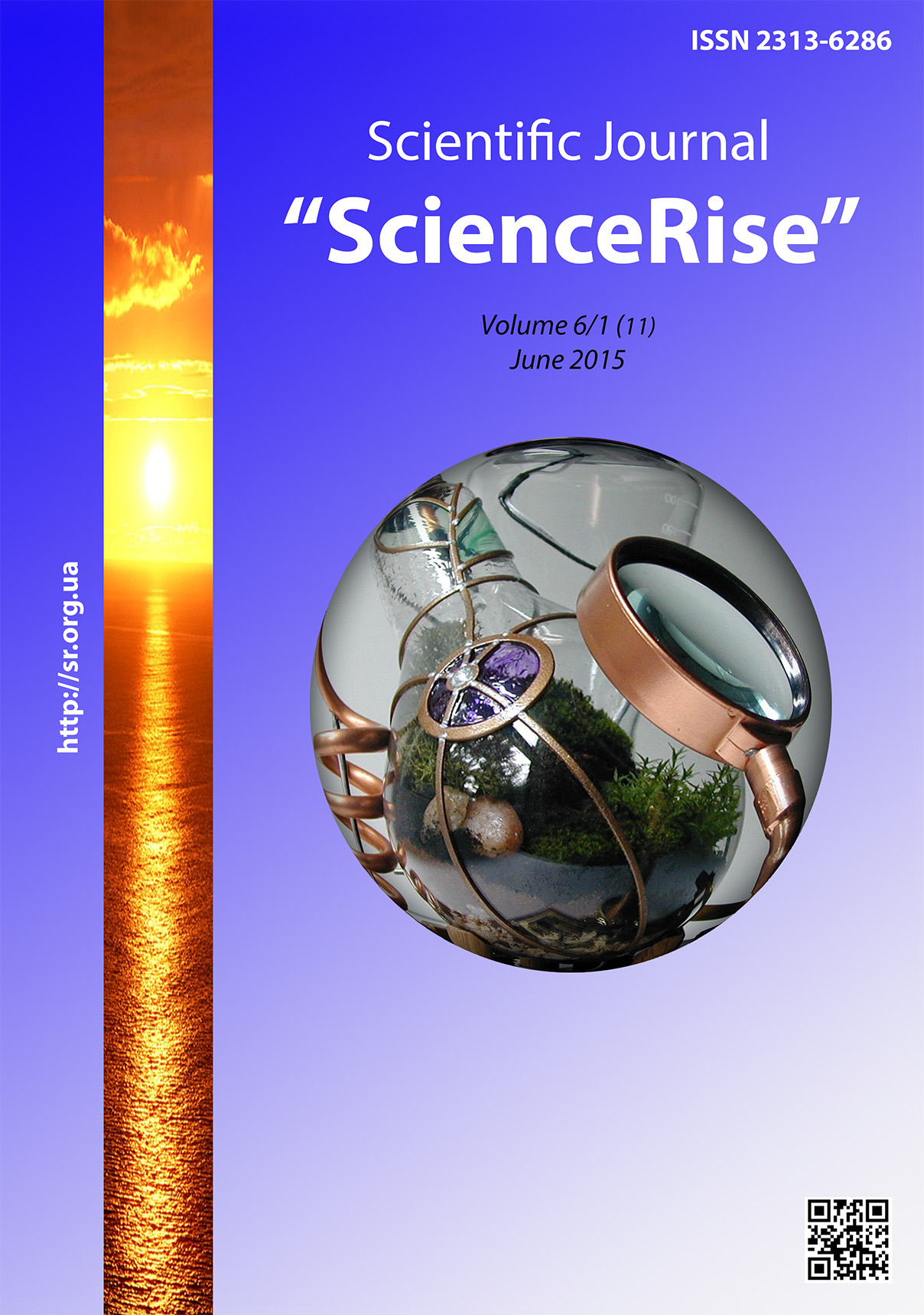Новий ензиматичний метод визначення L-аргініну за використання аргінази і людини та уреази
DOI:
https://doi.org/10.15587/2313-8416.2015.45126Ключові слова:
ензиматичний аналіз, аргіназа I, уреаза, о-фталевий альдегід, L-аргінін, сечовина, амоній, спектрофотометріяАнотація
Розроблено чутливий та селективний метод кількісного аналізу L-Аргініну із спектрофотометричним способом детектування продукту реакції (амонію) за допомогою о-фталевого альдегіду. Метод базується на використанні високоочищеної аргінази І та комерційної уреази. Новому методу властива висока порогова чутливість визначення L-Аргініну, широкий діапазон лінійності, а також нечутливість до інтерферуючого впливу широкого спектру амінокислот
Посилання
Yokoro, M., Suzuki, M., Murota, K., Otsuka, C., Yamashita, H., Takahashi, Y. et. al. (2012). Asymmetric Dimethylarginine, an Endogenous NOS Inhibitor, Is Actively Metabolized in Rat Erythrocytes. Bioscience, Biotechnology and Biochemistry, 76 (7), 1334–1342. doi: 10.1271/bbb.120086
Rotondo, R., Mastracci, L., Piazza, T., Barisione, G., Fabbi, M., Cassanello, M. et. al. (2008). Arginase 2 is expressed by human lung cancer, but it neither induces immune suppression, nor affects disease progression. International Journal of Cancer, 123 (5), 1108–1116. doi: 10.1002/ijc.23437
Lam, T.-L., Wong, G. K. Y., Chow, H.-Y., Chong, H.-C., Chow, T.-L., Kwok, S.-Y. et. al. (2010). Recombinant human arginase inhibits the in vitro and in vivo proliferation of human melanoma by inducing cell cycle arrest and apoptosis. Pigment Cell & Melanoma Research, 24 (2), 366–376. doi: 10.1111/j.1755-148x.2010.00798.x
Glazer, E. S., Stone, E. M., Zhu, C. et al. (2011). Bioengineered human arginase I with enhanced activity and stability controls hepatocellular and pancreatic carcinoma Transl. Oncol, 4 (3), 138–146.
Glazer, E. S., Stone, E. M., Zhu, C., Massey, K. L., Hamir, A. N., & Curley, S. A. (2011). Bioengineered Human Arginase I with Enhanced Activity and Stability Controls Hepatocellular and Pancreatic Carcinoma Xenografts. Translational Oncology, 4(3), 138–146. doi: 10.1593/tlo.10265
Morales, S. M. Cystinuria: diagnosis and therapeutic approach. (2011). An. Sist. Sanit. Navar, 34 (3), 453–461.
Lacroix, C., Caubet, C., Gonzalez-de-Peredo, A., Breuil, B., Bouyssié, D., Stella, A. et. al. (2014). Label-free Quantitative Urinary Proteomics Identifies the Arginase Pathway as a New Player in Congenital Obstructive Nephropathy. Molecular & Cellular Proteomics, 13 (12), 3421–3434. doi: 10.1074/mcp.m114.040121
Cohen, S. I. (1960). The determination of arginine released in human blood plasma after plasminogen activation. Use of a cation-exchange resin. Archives of Biochemistry and Biophysics, 86 (2), 166–168. doi: 10.1016/0003-9861(60)90397-0
Costin, J., Paul, F., Lewis, S. (2003). Selective determination of amino acids using flow injection analyses coupled with chemiluminescence detection, Anal. Chim. Acta., 408 (1), 67–77.
Fritz, J. H. (2013). Arginine Cools the Inflamed Gut. Infection and Immunity, 81 (10), 3500–3502. doi: 10.1128/iai.00789-13
Gayda, G. Z., Stasyuk, N. Ye., Gonchar, M. V. (2014). The methods of L-Arginine analysis (Review), Biotechnologia Acta, 7 (1). 31–39. doi: 10.15407/biotech7.01.031
Stasyuk, N.,Smutok, O., Gayda, G. et al. (2011). A new bi-enzyme potentiometric sensor for arginine analysis based on recombinant human arginase I and commercial urease. J. Mater. Sci. Eng. A., 1 (6), 819–827.
Stasyuk, N., Smutok, O., Gayda, G., Vus, B., Koval’chuk, Y., Gonchar, M. (2012). Bi-enzyme l-arginine-selective amperometric biosensor based on ammonium-sensing polyaniline-modified electrode. Biosensors and Bioelectronics, 37 (1), 46–52. doi: 10.1016/j.bios.2012.04.031
Stasyuk, N. E., Gaida, G. Z., Gonchar, M. V. (2013). L-arginine assay with the use of arginase I. Appl Biochem Microbiol, 49 (5), 529–534. doi: 10.1134/s000368381305013x
Mira de Orduña, R. (2001). Quantitative Determination of l -Arginine by Enzymatic End-Point Analysis. Journal of Agricultural and Food Chemistry, 49 (2), 549–552. doi: 10.1021/jf000522y
Gaede, G., Grieshaber, M. (1975). A rapid and specific enzymatic method for the estimation of l-arginine. Analytical Biochemistry, 66 (2), 393–399. doi: 10.1016/0003-2697(75)90606-5
Stasyuk, N., Gayda, G., Gayda, A. et al. (2011). The synthesis of affinity sorbents for purification of human arginase I from the recombinant yeast Hansenula polymorpha. Proc. Shevchenko Sci. Soc. Ser. Biochem, 28, 139–149.
Menshykov, V. V. (1987). The methods of laboratory investigations in clinical diagnostics. Мoscow: Мedicine, 215–219.
Kuo, M. T., Savaraj, N., Feun, L. G. (2010). Targeted cellular metabolism for cancer chemotherapy with recombinant arginine-degrading enzymes. Oncotarget, 1 (4), 246–251.
Goyal, S. S., Rains, D. W., Huffaker, R. C. (1988). Determination of ammonium ion by fluorometry or spectrophotometry after on-line derivatization with o-phthalaldehyde. Analytical Chemistry, 60 (2), 175–179. doi: 10.1021/ac00153a016
Ekanayake, S., Skog, K., Asp, N.-G. (2007). Canavanine content in sword beans (Canavalia gladiata): Analysis and effect of processing. Food and Chemical Toxicology, 45 (5), 797–803. doi: 10.1016/j.fct.2006.10.030
L-Arginine/Urea/Ammonia, UV method. Available at: https://www.nzytech.com/products-services/analytical-test-kits/ak00171/
Stasyuk, N. Ye., Gayda, G. Z., Gayda, A. V. et al. (2012). Enzymatic assay of L-arginine by the use of recombinant human arginase I. Ukrainica Biorganica Acta, 1, 31–37.
##submission.downloads##
Опубліковано
Номер
Розділ
Ліцензія
Авторське право (c) 2015 Галина Зуфарівна Гайда, Наталія Євгенівна Стасюк, Суренівна Єпрємян Хасмік, Михайло Васильович Гончар, Софія Ростиславівна Басс

Ця робота ліцензується відповідно до Creative Commons Attribution 4.0 International License.
Наше видання використовує положення про авторські права Creative Commons CC BY для журналів відкритого доступу.
Автори, які публікуються у цьому журналі, погоджуються з наступними умовами:
1. Автори залишають за собою право на авторство своєї роботи та передають журналу право першої публікації цієї роботи на умовах ліцензії Creative Commons CC BY, котра дозволяє іншим особам вільно розповсюджувати опубліковану роботу з обов'язковим посиланням на авторів оригінальної роботи та першу публікацію роботи у цьому журналі.
2. Автори мають право укладати самостійні додаткові угоди щодо неексклюзивного розповсюдження роботи у тому вигляді, в якому вона була опублікована цим журналом (наприклад, розміщувати роботу в електронному сховищі установи або публікувати у складі монографії), за умови збереження посилання на першу публікацію роботи у цьому журналі.

